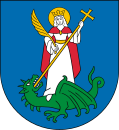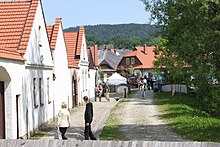Nowy Sącz
| Nowy Sącz | ||
|---|---|---|

|
|
|
| Basic data | ||
| State : | Poland | |
| Voivodeship : | Lesser Poland | |
| Powiat : | District-free city | |
| Area : | 57.00 km² | |
| Geographic location : | 49 ° 37 ′ N , 20 ° 42 ′ E | |
| Height : | 290 m npm | |
| Residents : | 83,813 (Jun. 30, 2019) |
|
| Postal code : | 33-300 | |
| Telephone code : | (+48) 18 | |
| License plate : | KN | |
| Economy and Transport | ||
| Street : | DK 28 Rabka-Zdrój - Jasło | |
| DK 75 Brzesko - Muszynka | ||
| DK 87 Nowy Sącz– Piwniczna-Zdrój | ||
| Rail route : | Tarnów – Muszyna | |
| Chabówka – Nowy Sącz | ||
| Next international airport : | Krakow-Balice | |
| Gmina | ||
| Gminatype: | Borough | |
| Surface: | 57.00 km² | |
| Residents: | 83,813 (Jun. 30, 2019) |
|
| Population density : | 1470 inhabitants / km² | |
| Community number ( GUS ): | 1262011 | |
| Administration (as of 2018) | ||
| City President : | Ludomir Handzel | |
| Address: | Rynek 1 33-300 Nowy Sącz |
|
| Website : | www.nowysacz.pl | |
Nowy Sącz [ ˈnɔvɘ̟ˈsɔ̃ʈ͡ʂ ] ( German : Neu Sandez or older Neu Sandec ; Hungarian : Újszandec ) is a town in the Polish Lesser Poland Voivodeship and has about 84,000 inhabitants. The town lies north of the Sacz Beskid (Beskid Sadecki) in a valley widening at the mouth of Kamienica in the Dunajec to 290 m above sea level and is a regional industrial and service center.
history
The place was laid out in 1292 by King Wenceslaus II of Bohemia , and he received town charter in the 14th century from Władysław I. Ellenlang . According to Kurt Lück , German residents made up about 3/4 of the city's population in the 15th century. Only in 1469 was a Polish priest installed in the parish church.
Special privileges granted by Casimir the Great made the city rise rapidly. The devastating fire of 1611, epidemics and wars then caused the decline.
From 1772 the city belonged to the Austrian crown land of Galicia and became an important administrative center there, from 1774 to 1782 briefly the seat of a district office, was then converted into a district office until 1876 and was then in Galicia until the end of Austrian rule (fell to Poland in 1918 ) Seat of a district administration . In the course of the Josephine colonization , 235 German families were settled in the area of Nowy Sącz. Officials and craftsmen from German-speaking countries also came to the city. In 1800 a Protestant congregation was organized in the Franciscan Church. In the first half of the 19th century the place became an important center of Hasidism , here Chaim Halberstam worked as a rabbi from 1830.
During the First World War , the main command of part of the Eastern Front ( Przemyśl ) of the allied troops of Austria-Hungary and the German Empire was in Neu Sandez for a short time . Before the Second World War, 10,000 Jews lived in Nowy Sącz, that was a third of the population. In July 1941 the Jewish inhabitants were ghettoized, in August 1942 about 20,000 Jews lived in the ghetto before they were deported to the Belzec extermination camp .
The city and its eastern surroundings (see Lemkenland ) had for a long time an important Ruthenian or Ukrainian (1928 the name was officially changed from Ruthenian to Ukrainian ) population, many of them Lemken , but who also developed a separate identity for the most part. After the end of the Second World War, most of the Lemks and Ukrainians were deported to the Soviet Union as part of the Vistula Action , where they mostly settled in the Ukrainian SSR .
From 1975 to 1998 Nowy Sącz was the capital of the Nowy Sącz Voivodeship .
Politics and administration
City President
At the head of the city administration is the city president . From 2006 to 2018, this was Ryszard Nowak ( PiS ), who was no longer elected by his party in the regular election in October 2018. The result was as follows:
- Iwona Mularczyk ( Prawo i Sprawiedliwość ) 28.4% of the vote
- Ludomir Handzel (Election Committee “National Coalition Ludomir Handzel”) 25.8% of the votes
- Krzysztof Głuc (Election Committee Krzysztof Głuc “I elect Nowy Sącz”) 20.6% of the vote
- Leszek Zegzda ( Koalicja Obywatelska ) 16.0% of the vote
- Małgorzata Belska (Election Committee “Małgorzata Belska, Lucjan Stępień - for a New Nowy Sącz”) 5.3% of the vote
- Jerzy Gwiżdż (Jerzy Gwiżdż Election Committee “Self-Government for Nowy Sącz”) 3.4% of the vote
- Remaining 1.2% of the vote
In the runoff election that became necessary, Handzel, the runner-up in the first round, prevailed against the PiS candidate Mularczyk with 58.4% of the votes and became the new mayor.
City council
The city council has 23 members who are directly elected. The election in October 2018 led to the following result:
- Prawo i Sprawiedliwość (PiS) 34.0% of the vote, 9 seats
- Koalicja Obywatelska (KO) 20.3% of the vote, 5 seats
- Election committee Krzysztof Głuc “I vote Nowy Sącz” 20.1% of the vote, 5 seats
- Election Committee "National Coalition Ludomir Handzel" 15.5% of the vote, 4 seats
- Election committee "Małgorzata Belska, Lucjan Stępień - for a new Nowy Sącz" 3.7% of the vote, no seat
- Jerzy Gwiżdż Electoral Committee “Self-Government for Nowy Sącz” 3.4% of the vote, no seat
- Sojusz Lewicy Demokratycznej (SLD) / Lewica Razem (Razem) 3.0% of the votes, no seat
Town twinning

Nowy Sącz has 12 town partnerships:
- Columbia County (USA)
- Elblag (Poland)
- Kiskunhalas (Hungary)
- Massa (Italy), since 2007
- Narvik (Norway)
- Netanya (Israel)
- Prešov (Slovakia)
- Schwerte (Germany), since 1984 (suspended from May 2020)
- Stará Ľubovňa (Slovakia)
- Stryj (Ukraine)
- Tarnów (Poland)
- Trakai (Lithuania)
The city of Schwerte suspended the partnership on IDAHOBIT 2020 after the Polish city declared itself an "LGBT-ideology-free" zone .
Worth seeing
- Old town
- Margaret Church
- city Museum
- Holy Spirit Church
- Old Synagogue, in 1600 received the Jews from Starost permission to a brick synagogue to build
- town hall
- Nowy Sącz Castle
- Open-air museum in Falkowa (Nowy Sącz)
Personalities
sons and daughters of the town
- Johannes Maletius (≈1492–1567), Polish printer, theologian and translator of the Reformation period
- Alberta von Maytner (1835–1898), Austrian writer
- Carl Menger (1840–1921), Austrian economist
- Arthur Berson (1859–1942), German meteorologist and balloonist
- Heinrich Färber (1864–1941), Austrian economist and founder of the ergocracy
- Isidor Sadger (1867–1942), Austrian psychoanalyst
- Bolesław Raczyński (1879–1937), Polish composer and music teacher
- Volodymyr Kubijowytsch (1900–1985), Ukrainian historian, ethnographer, geographer and lexicographer
- Tadeusz Friedrich (1903–1976), fencer
- Jerzy Wójcik (1930–2019), cameraman
- Józef Oleksy (1946–2015), Prime Minister 1995–96
- Wiesław Fiedor (* 1964), Paralympics
- Marek Świerczewski (* 1967), football player
- Marek Gróbarczyk (* 1968), politician
- Piotr Świerczewski (* 1972), football player
- Piotr Klimczak (* 1980), athlete
- Dawid Janczyk (* 1987), football player
- Marcin Gawron (* 1988), tennis player
- Adam Jarzmik (* 1990), jazz pianist
Other personalities associated with the city
- Ernst Hein (1887–1950), city commissioner 1939/40
- Emanuel Ringelblum (1900–1944), Polish-Jewish historian, politician, educator and publicist, spent his youth here
literature
- Nowy Sącz , in: Guy Miron (Ed.): The Yad Vashem encyclopedia of the ghettos during the Holocaust . Jerusalem: Yad Vashem, 2009 ISBN 978-965-308-345-5 , pp. 532-536
Web links
- City website (multilingual)
- Photos Królewskie Wolne Miasto Nowy Sacz (English)
- Photos of Nowy Sacz (English)
- About the city's Jewish cemetery - and the man who receives it (German)
Individual evidence
- ↑ a b population. Size and Structure by Territorial Division. As of June 30, 2019. Główny Urząd Statystyczny (GUS) (PDF files; 0.99 MiB), accessed on December 24, 2019 .
- ^ A b Bogdan Mościcki: Beskid Sądecki. Przewodnik . Oficyna Wydawnicza "Rewasz", Pruszków 2007, ISBN 978-83-8918865-6 , p. 204-209 (Polish).
- ↑ German settlement of Malopolska and Rotreussens in the 15th century . Edited u. drawn by Kurt Lück, 1934.
- ↑ Colony Józefa (PDF) (Polish)
- ↑ History of the Jews in Nowy Sącz (Polish)
- ↑ Witold Grzesik Tomasz Traczyk, Bartłomiej Wada: Beskid Niski od Komańczy do Wysowej . Sklep Podróżniczy, Warszawa 2012, ISBN 978-83-7136-087-9 , p. 391 (Polish).
- ↑ http://www.encyclopediaofukraine.com/display.asp?linkpath=pages%5CN%5CO%5CNowySJ8cz.htm
- ↑ Magdalena Palka: The forgotten people of the Lemken. An ethnic minority in search of their identity . Vienna 2012 ( Online [PDF]).
- ^ Result on the website of the election commission, accessed on August 16, 2020.
- ^ Result on the website of the election commission, accessed on August 16, 2020.
- ↑ Queer.de: Schwerte suspends town twinning with Poland. May 17, 2020, accessed on May 17, 2020 (German).
- ↑ Stephan Wendehorst (ed.). (2015): The Anatomy of Early Modern Empires: Rule Management Beyond State and Nation. Oldenburg, Walter de Gruyter. ISBN 978-3-486-57911-6 .







